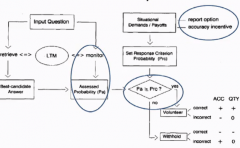![]()
![]()
![]()
Use LEFT and RIGHT arrow keys to navigate between flashcards;
Use UP and DOWN arrow keys to flip the card;
H to show hint;
A reads text to speech;
20 Cards in this Set
- Front
- Back
|
What is metacognition? |
* Beliefs about our own cognitive processes/how our memory works * "processes involved in monitoring and controlling performance on a task" * individual's ability to monitor & control their own performance |
|
|
What is Monitoring & how is it measured? |
Processes that allow us to observe and reflect on our own cognition, eg occurs when we're attempting to retrieve a memory (how long is this taking? how sure am i?) Measured by asking people to report their own subjective experience & see how well that corresponds with actual performance |
|
|
What is are the 4 methods of measuring monitoring? |
1. Ease-of-learning - Underwood (1966) 2. Judgement-of-knowing - for each item learned, how likely is it you will recall them later? 3. Feeling-of-knowing Hart (1965) 4. Confidence - for items recalls/recognised, how likely is it your decision is correct? Semmler (ongoing) |
|
|
What is Control & how is it measured? |
Conscious & non-conscious decisions we make based on the output of our monitoring processes, measured (revealed) by behaviours - what the person does |
|
|
What are 5 methods for measuring control? |
* Self-paced study time * Response time (recognition & recall) * Quantity of information reported * Truth/correspondence of information reported * Grain-size of information reported (detailed or vague) |
|
|
What is metacognition a predictor of? |
Performance. (eg the better your metacognition, more likely you are to dedicate the correct time to study, more likely you are to perform better) |
|
|
What is the direct-access view of FOK? |
people can access a notion of memory strength for a learned item, judgments are made on the basis of features of the target item to be accessed/retrieved |
|
|
What is the problem with the direct-access view? |
weakly stored info should never be predicted to be more recallable than 'strongly' stored info, no longer used (disproved) |
|
|
What is the inferential view? |
Judgements are based on cues & clues. might be based in feeling or about a theory about what makes info memorable - ie fluency recalled or amt of info retrieved |
|
|
What is cue visualisation theory (hybrid view) |
* experience based cues - feelings, TOT, trying to remember a name of an actor * information based cues - 'the longer I see something, the more I will remember'. Logical. |
|
|
What is feeling of knowing? |
Also known as 'tip of the tongue' phenomena. Hart (1965) if participants couldn't recall general knowledge, they were asked if they'd recognise it in MCQ, their answers correlated with their accuracy. |
|
|
What is ease-of-learning? |
Before you learn the items, how difficult will it be to learn these? Underwood (1965), participants judged speed of recall and found judgements predict recall performance on 'surprise' and intentional recall |
|
|
What is the storehouse approach? |
quantity oriented - how much of the input is recovered in the output |
|
|
What is the correspondence approach? |
accuracy oriented - does what occurred correspond with what is reported? |
|
|
How do the storehouse vs correspondence approach assess memory in a list form? |
omissions are treated differently; eg performace 8 words correct, 2 words incorrecgfdgngcvdht & 2 blanks = 8/12 storehouse & 8/10 correspondence, (more reflective of RL as you can't test people on what they don't know). |
|
|
What is the recall recognition paradox |
Recognition is better in labs Recall is better in real-world settings like eyewitness studies |
|
|
Why does the recall recognition paradox occur? (three reasons) |
Different test parameters; 1. Accuracy (witness) vs quantity (lab) 2. Report option - forced (lab - must respond) vs free (witness - can say 'don't know') 3. Test format - recall vs recognition |
|
|
What did Koriat & Goldsmith (1994) find for test format x report option? |
Test format (recognition vs recall): - did affect quantity - did not affect accuracy Response (free vs forced): - did not affect quantity - did affect accuracy first evidence of quantity/accuracy trade-off when increased incentive in exp 3, people decreased quantity but increased accuracy |
|
|
What is the model of monitoring & control in memory? |

|
|
|
Using Koriat and Goldsmith’s monitoring andcontrol framework (1996), set out the likely effects of an incentiveprogram on witnesses’ memory reports and recommend the best way for Police to implementan incentive scheme. |
* Witness will adopt a less stringent criterion for reporting info, which means increase in quantity of info but decrease in accuracy * No way to determine which piecesof info are correct * Better incentive: provide money if the details are bothinformative & accurate (corroborated by other physical evidence perhaps) to encourage witnesses to adjust report criterion to effectively trade–off between quantity & accuracy |

